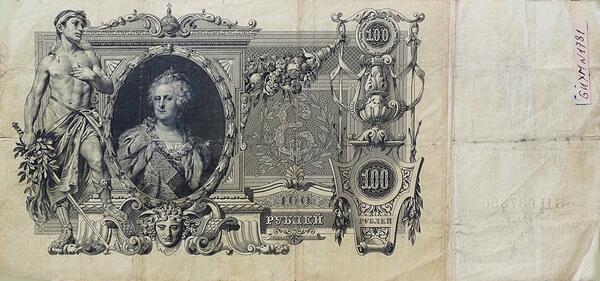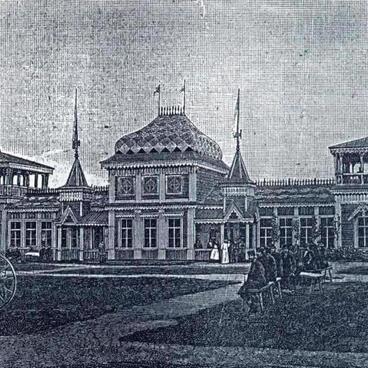This type of a credit note is one of the biggest currency notes in terms of their size. Such credit notes were issued since 1911 in Saint Petersburg. They were the addition to the currency notes issued in 1898.
The design of the bon was created by a Latvian artist Rihards Zariņš (1896-1939). The note’s obverse is divided into two parts with an empty space and a watermark in the right part, and a left one painted with beige colour with the lettering 100 and RUB. The lower part is decorated with floral ornament. Also the Lesser Coat of Arms of 1883 is situated in the upper-left corner. The central part is decorated with the bas reliefs, palm branches, laurel branches, which symbolize peace and victory, and a few fruits on the side as an allegory of fruitfulness. On the top there are two rosettes with number 100. In the middle part there’s inscription ‘THE STATE CREDIT NOTE 100 ROUBLES’. In the lower part there’s a text: “The State Bank exchanges credit notes to the coined gold…” The place for manager’s and cashier’s signatures is left. In the upper-right corner there’s a monogram of Nicolas II framed in the figured box.
The reverse of the note is also divided into two parts. The left part is bigger and has a picture in it, the second one is narrower, its space is left empty. The picture in the left part is the architectural elements of baroque style. In the centre there’s a portrait of Empress Catherine the Great in the oval floral frame. To the left from the frame is an image of a man in antique clothes holding a laurel branch and a sword in his right hand. To the right is the Empress’s monogram with the horn of abundance above it. The whole composition is filled with symbols and allegories of power, strength, and victory.
The portrait of Empress Catherine the Great was chosen for a reason, as she was the one who issued an edict to create the banks, which gave Russia the first irredeemable bank notes. The state credit note 100 roubles was lovingly called Katka, or Katenka (short for Catherine) among the usual people.
As a rule, each bank note had watermarks in it, a multiple number of repeating hundreds situated perpendicularly to each other. There was also a watermark with the Empress’s portrait.



